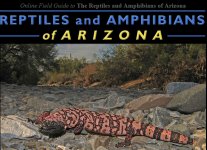| Range: |
 |
| Other Names: |
Desert Spiny Lizard |
| Description: |
A large (up to about 142 mm or 5.6" from snout to vent), stocky lizard with large, pointed, keeled, overlapping scales. Base coloration is gray, tan, or brown. Adults often have a yellow or orange head. Yellow or orange scales are scattered on the sides of the body. A black wedge shape marks each shoulder. Males have two large, bright, blue-green patches on the belly and a blue-green patch on the throat. Belly and throat patches are faint or absent in females. |
| Similar Species: |
Its large, black, wedge-shaped shoulder markings distinguish this lizard from New Mexico's smaller Sceloporus. Its yellow or orange head distinguishes this lizard from the similar Twin-spotted Spiny Lizard. |
| Venom: |
None |
| Habitat: |
Biotic communities including Great Basin Desertscrub, Semidesert Grassland, Interior Chaparral, and woodlands are home to this lizard. It is usually encountered on lower slopes, bajadas, plains, and low valleys, often in the branches of trees or in the vicinity of ground cover such as wood piles, rock piles, and packrat nests. |
| Behavior: |
This diurnal lizard basks on the branches of trees, on rocks, or on other sunlit perches. When encountered it is often heard before it is seen as it scratches and claws the bark en route to the opposite side of the trunk or branch. It flees down into the inner tangles of pack rat nests, rock crevices, or burrows when threatened. It has a strong jaw and often bites when captured. |
| Hibernation: |
It hibernates during the cold months of winter and late fall. |
| Reproduction: |
It is often encountered in male-female pairs. Mating takes place in spring and summer and one or two clutches of eggs are laid in spring and summer. Clutch size ranges from 2 to 12 eggs. Hatchlings may appear as early as late May but usually begin to emerge in July. |
| Diet: |
The Desert Spiny Lizard feeds on a variety of insects including ants, beetles, and caterpillars. It also feeds on spiders, centipedes, small lizards, and some plant material. |
Adapted from account on reptilesofaz.org
Sources:


|









